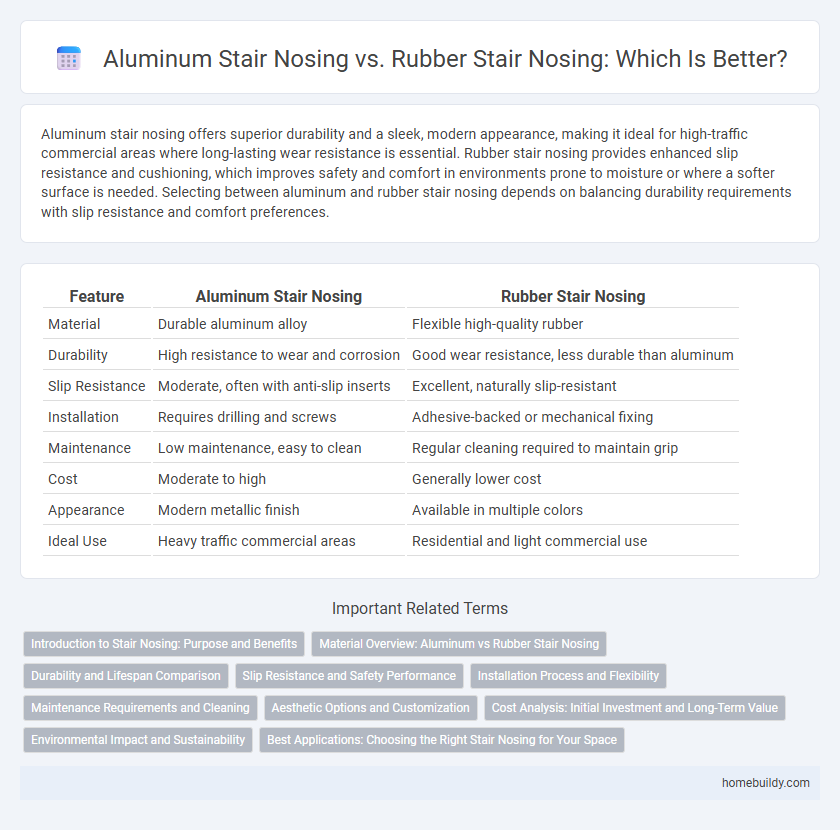Aluminum stair nosing offers superior durability and a sleek, modern appearance, making it ideal for high-traffic commercial areas where long-lasting wear resistance is essential. Rubber stair nosing provides enhanced slip resistance and cushioning, which improves safety and comfort in environments prone to moisture or where a softer surface is needed. Selecting between aluminum and rubber stair nosing depends on balancing durability requirements with slip resistance and comfort preferences.
Table of Comparison
| Feature | Aluminum Stair Nosing | Rubber Stair Nosing |
|---|---|---|
| Material | Durable aluminum alloy | Flexible high-quality rubber |
| Durability | High resistance to wear and corrosion | Good wear resistance, less durable than aluminum |
| Slip Resistance | Moderate, often with anti-slip inserts | Excellent, naturally slip-resistant |
| Installation | Requires drilling and screws | Adhesive-backed or mechanical fixing |
| Maintenance | Low maintenance, easy to clean | Regular cleaning required to maintain grip |
| Cost | Moderate to high | Generally lower cost |
| Appearance | Modern metallic finish | Available in multiple colors |
| Ideal Use | Heavy traffic commercial areas | Residential and light commercial use |
Introduction to Stair Nosing: Purpose and Benefits
Aluminum stair nosing provides exceptional durability and corrosion resistance, making it ideal for high-traffic areas and outdoor use. Rubber stair nosing offers superior slip resistance and cushioning, enhancing safety and comfort on stairs prone to moisture or heavy foot traffic. Both types improve stair edge visibility, reduce wear, and prevent accidents by reinforcing the stair tread's most vulnerable point.
Material Overview: Aluminum vs Rubber Stair Nosing
Aluminum stair nosing offers exceptional durability, corrosion resistance, and a sleek metallic finish ideal for high-traffic commercial areas, ensuring long-term performance and minimal maintenance. Rubber stair nosing provides superior slip resistance, shock absorption, and sound dampening, making it suitable for environments where safety and comfort are priorities. Choosing between aluminum and rubber stair nosing depends on the specific requirements for strength, safety, and aesthetic preferences in stair design.
Durability and Lifespan Comparison
Aluminum stair nosing offers superior durability and a longer lifespan compared to rubber stair nosing, making it ideal for high-traffic areas and outdoor installations. Its resistance to corrosion, wear, and impact ensures years of reliable performance without significant degradation. In contrast, rubber stair nosing, while providing excellent slip resistance and shock absorption, tends to wear out faster, especially under heavy foot traffic or exposure to harsh environmental conditions.
Slip Resistance and Safety Performance
Aluminum stair nosing offers high durability and excellent slip resistance with integrated abrasive surfaces, making it ideal for heavy-traffic areas prone to wear. Rubber stair nosing provides superior shock absorption and grip due to its flexible, non-slip texture, enhancing safety in wet or oily conditions. Both materials significantly improve stair safety, but rubber excels in slip resistance on slippery surfaces, while aluminum is better suited for long-lasting structural protection.
Installation Process and Flexibility
Aluminum stair nosing offers a straightforward installation process using screws or anchors, providing a rigid, durable edge suitable for both indoor and outdoor applications. Rubber stair nosing features a flexible design that conforms easily to curved or uneven surfaces, often installed with adhesive or mechanical fasteners for enhanced grip. The flexibility of rubber nosing allows for better shock absorption and slip resistance compared to the rigid, corrosion-resistant properties of aluminum nosing.
Maintenance Requirements and Cleaning
Aluminum stair tread nosings demand minimal maintenance due to their corrosion resistance and durability, requiring only periodic cleaning with mild detergents to prevent dirt buildup. Rubber stair nosings necessitate more frequent cleaning to remove dirt and grime, as their porous surface can trap debris, and they may require occasional inspection for wear or damage. Both materials benefit from routine cleaning, but aluminum's smooth surface simplifies maintenance while rubber offers slip resistance despite higher upkeep.
Aesthetic Options and Customization
Aluminum stair nosing offers a sleek, modern aesthetic with anodized finishes and color anodizing options, allowing for a wide range of customization to match architectural designs. Rubber stair nosing provides versatile color choices and textured patterns that enhance grip while blending seamlessly with various interior styles. Both materials support custom sizing and shapes, but aluminum excels in achieving a polished look ideal for contemporary environments.
Cost Analysis: Initial Investment and Long-Term Value
Aluminum stair nosing typically requires a higher initial investment due to material and installation costs but offers superior durability and corrosion resistance, reducing maintenance expenses over time. Rubber stair nosing presents a lower upfront cost and enhanced slip resistance but may demand more frequent replacement and upkeep, potentially increasing long-term expenses. Evaluating the total cost of ownership reveals aluminum as a cost-effective option for high-traffic areas, while rubber suits budget-conscious projects with lower traffic demands.
Environmental Impact and Sustainability
Aluminum stair tread nosing, known for its durability and recyclability, often contributes to reduced environmental waste due to its long lifespan and ability to be remelted and reused. Rubber stair nosing, typically derived from natural or synthetic materials, offers benefits in terms of biodegradability for natural rubber but may pose challenges in recycling and chemical stability for synthetic variants. Prioritizing sustainable sourcing and end-of-life management is crucial for minimizing the environmental footprint of both aluminum and rubber stair nosing products.
Best Applications: Choosing the Right Stair Nosing for Your Space
Aluminum stair nosing offers exceptional durability and corrosion resistance, making it ideal for high-traffic commercial or industrial environments where longevity and safety are critical. Rubber stair nosing provides superior slip resistance and cushioning, perfect for residential areas, schools, or spaces requiring enhanced comfort and noise reduction. Selecting the right stair tread nosing depends on usage frequency, environmental conditions, and safety requirements to ensure optimal performance and occupant protection.
Aluminum stair nosing vs Rubber stair nosing Infographic

 homebuildy.com
homebuildy.com